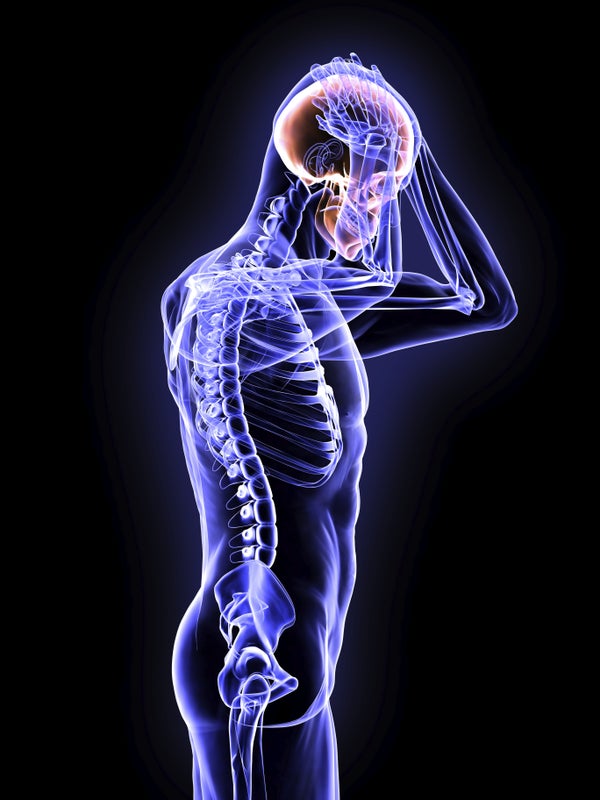This article was published in Scientific American’s former blog network and reflects the views of the author, not necessarily those of Scientific American
A blow to the head generates a hail of free radicals and inflammatory molecules that can cause lasting damage if left unchecked. A drug that could be administered within hours, or even a day or more after the injury, could help soldiers, athletes, and everyone really.
A report at the Society for Neuroscience meeting in Chicago this week showed that mice treated within hours after a lab-induced injury with a combination of an antibiotic and an antioxidant could avoid some of the neural chaos that results from a concussive blow. The apparent effectiveness of the drugs persisted even if they were not administered immediately—a desirable attribute in a traumatic brain drug because treatment is often not sought right away. So far, no drug has been approved for the condition.
Researchers from SUNY Downstate Medical Center, Brooklyn, N.Y., combined the FDA-approved antibiotic minocycline and the antioxidant N-acetylcysteine, both of which have previously been shown to have neuroprotective effects. One group of rats received the drugs 12 hours after receiving head injuries in a lab. The other ingested them a full day after. When tested a week later, the mice who received the drugs 12 hours later performed better on two tasks that tested cognition than did injured animals given only a placebo. Rats dosed after 24 hours did better than the placebo group on the easiest of the two tasks. Minocycline and N-acetylcysteine together worked better than either did alone. “Essentially the effect you see in combination is something you don’t see when giving the drugs in individual doses,” said Michael Sangobowale, a graduate student in the laboratory of Peter Bergold, during a press briefing.
On supporting science journalism
If you're enjoying this article, consider supporting our award-winning journalism by subscribing. By purchasing a subscription you are helping to ensure the future of impactful stories about the discoveries and ideas shaping our world today.
The two drugs also resulted in the preservation of myelin, the sheathing for the long, wire-like axons that stretch out like tentacles from a neuron’s central cell body—a kind of insulation essential for neurons to communicate properly.
The pragmatic approach of repurposing old drugs to meet an acute medical need makes abundant sense, even though it lacks the technological panache of a prototype for a portable PET-scan helmet—other research presented at the conference. Patents for both minocycline and N-acetylcysteine have expired, a decided advantage because it will keep costs low. N-acetylcysteine can even be purchased over the counter at shops selling supplements. Funding for the research came from the Department of Defense.
The idea for a relatively innocuous concoction that could be administered shortly after an injury is making the rounds. Akiva Cohen of the University of Pennsylvania, who moderated a press conference on traumatic brain injury at the conference at which Sangobawale discussed his work, is also developing a treatment, a kind of sports drink intended to help brain activity return to normal following a hard hit. Cohen didn’t go into details about what’s in the drink, but his laboratory has previously published in Science Translational Medicine on using precursors to the neurotransmitters glutamate and GABA—molecules called branched chain amino acids—as potential treatments. Glutamate and GABA balance out brain activity to ensure that neurons are neither over- or under-stimulated. No one expects a sports drink or the drug combo from SUNY Downstate to work miracles, but even a little protection for the brain tissue of a soldier on patrol or the climber on a remote mountain would be a welcome addition to an ice pack and an aspirin.
As always, the giant neuroscience gathering that attracts 30,000 or so attendees every year overflowed with early, mostly unpublished, research findings on every imaginable topic related to the three-pound wonder hidden underneath the skull. Traumatic brain injury was no exception. Studies in experimental animals pointed to the disparate effects of a blow to the head. Male and female, for instance, mice display different symptoms. The rodents also experience fearful behaviors reminiscent of PTSD. And, in children, not pups, certain populations of nerve cells are more vulnerable to traumatic brain injury.
The data dump at the brain fest bombarded attendees with information about such advances as the growing understanding of a specialized class of cells that acts as hedge clippers for neurons to make sure they have just the right number of connections to their neighbors, neither too few or too many, so that communication pathways keep humming—it also chronicled how autism or Alzheimer’s might emerge when this process goes awry.
My pick for the most amusing entry was an abstract with a headline that read: “What Happens to Mouse Hippocampal-Dependent Behavior and Neurogenesis on the Way to Mars? One Small Step for Mousekind.” It summarized a study that showed that exposure to space-like radiation—high-energy silicon particles, for instance—enhances learning and memory in adult mice. Earlier mouse studies had demonstrated that exposure to these particles did the opposite, but the tests were always carried out on young mice. In this case, mature mice learned faster on challenging lab tests after being zapped. This is decidedly good news for NASA, which funded the study. I wonder whether tanning salons will now install their own cosmic ray rooms
